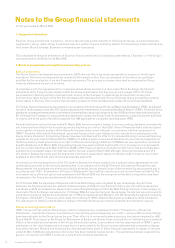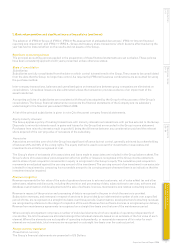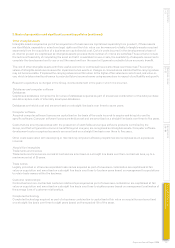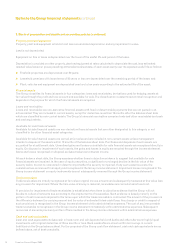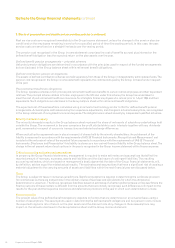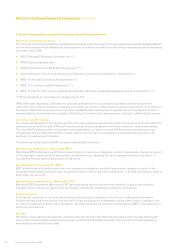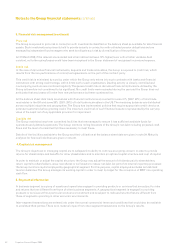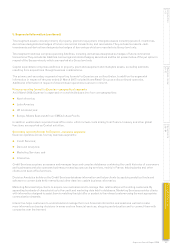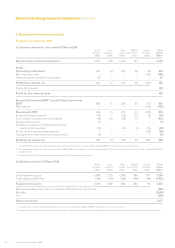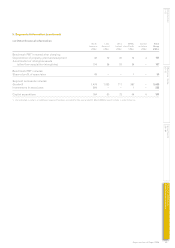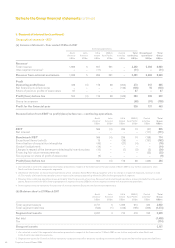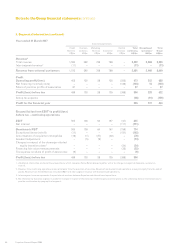Experian 2008 Annual Report Download - page 80
Download and view the complete annual report
Please find page 80 of the 2008 Experian annual report below. You can navigate through the pages in the report by either clicking on the pages listed below, or by using the keyword search tool below to find specific information within the annual report.78 Experian Annual Report 2008
2. Basis of preparation and significant accounting policies (continued)
Past service costs are recognised immediately in the Group income statement, unless the changes to the pension plan are
conditional on the employees remaining in service for a specified period of time (the vesting period). In this case, the past
service costs are amortised on a straight line basis over the vesting period.
The pension cost recognised in the Group income statement comprises the cost of benefits accrued plus interest on the
defined benefit obligation less the expected return on the plan assets over the year.
Defined benefit pension arrangements – unfunded schemes
Unfunded pension obligations are determined in accordance with the principles used In respect of the funded arrangements
but are disclosed in the Group balance sheet within retirement benefit obligations.
Defined contribution pension arrangements
The assets of defined contribution schemes are held separately from those of the Group in independently administered funds. The
pension cost recognised in the Group income statement represents the contributions paid by the Group to these funds in respect
of the year.
Post-retirement healthcare obligations
The Group operates schemes which provide post-retirement healthcare benefits to certain retired employees and their dependent
relatives. The principal scheme relates to former employees in the UK and, under this scheme, the Group has undertaken to
meet the cost of post-retirement healthcare insurance for all eligible former employees who retired prior to 1 April 1994 and their
dependants. Such obligations are disclosed in the Group balance sheet within retirement benefit obligations.
The expected cost of these benefits is calculated using an actuarial methodology similar to that for defined benefit pension
arrangements. Actuarial gains and losses arising from experience adjustments, and changes in actuarial assumptions, are recognised
in the Group statement of recognised income and expense. The obligations are valued annually by independent qualified actuaries.
Minority interests in equity
The minority interests in equity in the Group balance sheet represent the share of net assets of subsidiary undertakings held
outside the Group. The movement in the year comprises the profit attributable to such interests together with any dividends
paid, movements in respect of corporate transactions and related exchange differences.
Where put/call option agreements are in place in respect of shares held by the minority shareholders, the put element of the
liability is measured in accordance with the requirements of IAS 39 ‘Financial Instruments: Recognition and Measurement’ and
is stated at the net present value of the expected future payments. In accordance with the requirements of IAS 32 ‘Financial
Instruments: Disclosure and Presentation’ this liability is shown as a non-current financial liability in the Group balance sheet. The
change in the net present value of such options in the year is recognised in the Group income statement within finance expense.
Critical accounting estimates and assumptions
In preparing the Group financial statements, management is required to make estimates and assumptions that affect the
reported amount of revenues, expenses, assets and liabilities and the disclosure of contingent liabilities. The resulting
accounting estimates, which are based on management’s best judgment at the date of the Group financial statements, will,
by definition, seldom equal the related actual results. The estimates and assumptions that have a significant risk of causing a
material adjustment to the carrying amounts of assets and liabilities within the next financial year are discussed below.
Ta x e s
The Group is subject to taxes in numerous jurisdictions. Significant judgment is required in determining the worldwide provision
for income taxes as there are transactions in the ordinary course of business and calculations for which the ultimate tax
determination is uncertain. The Group recognises liabilities based on estimates of whether additional taxes will be due. Where the
final tax outcome of these matters is different from the amounts that were initially recognised, such differences will impact on the
results for the year and the respective income tax and deferred tax provisions in the year in which such determination is made.
Pension benefits
The present value of the defined benefit obligations depends on factors that are determined on an actuarial basis using a
number of assumptions. The assumptions used in determining the defined benefit obligations and net pension costs include
the expected long-term rate of return on the plan assets and the discount rate. Any changes in these assumptions may
impact on the amounts disclosed in the Group balance sheet and the Group income statement.
Notes to the Group financial statements continued




